Crop Protection Chemicals Industry Size, Growth Insights and Forecast to 2032
The global crop protection chemicals industry size is projected to reach USD 97.01 billion in 2032, exhibiting a CAGR of 5.30% during the forecast period.

The global Crop Protection Chemicals Industry size is projected to reach USD 97.01 billion in 2032, exhibiting a CAGR of 5.30% during the forecast period. The increasing pesticide resistance among new crop pests is expected to be one of the main factors driving the adoption of crop protection chemicals, according to Fortune Business Insights™ in its recent report titled, “Crop Protection Chemicals Market, 2024-2032”. The market size stood at USD 61.42 billion in 2023.
Over the years, the crop protection chemical sector has undergone significant transformation because to its rapid expansion, shifting crop mix patterns, and environmental laws. Growing agricultural output is required to provide food security, a growing population, dwindling arable land, and the need for increased agricultural productivity. These significant considerations are also driving the rise of the crop protection business globally.

Information Source: https://www.fortunebusinessinsights.com/industry-reports/crop-protection-chemicals-market-100080
Segmentation-
The market is divided into fungicides, herbicides, insecticides, and other categories based on kind. The market is divided into furits and vegetables, oilseeds and pulses, cereals, and other categories based on the type of produce. The market is divided into categories such as foliar spray, soil treatment, seed treatment, and others based on the method of application. The market is divided geographically into the Middle East and Africa, Europe, Asia Pacific, South America, and North America.
Report Coverage:
The study offers a thorough analysis of the variables promoting and limiting market expansion. It provides in-depth analysis on all industry categories. The research includes in-depth analyses and profiles of the main industry participants and their tactics. It also offers a thorough analysis of the regional dynamics and how they affect the industry.
Drivers and Restraints:
Growing Priority for Enhanced Crop Production to Support Economic Growth
The implementation of resistant cultivars, cultural practices, and biological control are components of an integrated pest management plan that prioritises long-term pest prevention. The least level of damage to human and animal health is achieved by proper pest management through the application of a range of pest control techniques and in-depth understanding of the life cycle and interactions of pests. Farmers are therefore favoring these techniques because they reduce the environmental risks associated with pest control. This element will make it possible for the market to grow. In rice and cotton harvests, for instance, integrated pest management techniques have increased agricultural crop output by 40.14% and 26.63%, respectively, according to the Directorate of Plant Protection Quarantine & Storage (India).
The study's conclusions show that, since the turn of the century, global insect pest losses have dropped from 13.6% in the post-green revolution era to 10.8%. Significant modifications to agricultural production systems, the application of crop protection agents, increased knowledge of field and post-harvest losses, and crucial management practices have all contributed to a decline in pest infestations.
The development of pests' resistance to crop pesticides, however, might impede market expansion.
Regional Insights
Market participants will have lucrative growth opportunities in Asia Pacific.
Asia Pacific is expected to hold the largest share of the crop protection chemicals market during the forecast period, with a projected value of USD 16.54 billion in 2020. The main factor propelling the expansion of the regional market is the emerging countries' heavy reliance on agriculture, which serves as the foundation of their economy. These nations' growing populations and pervasive poverty are making it more important than ever to increase agricultural output in order to guarantee population food security. Thus, it is anticipated that in the upcoming years, crop protection agents and pesticides would become more widely used throughout Asia Pacific. Farmers in North America and Europe are quickly adopting sustainable farming methods, and they are becoming more and more interested in using environmentally friendly and naturally derived insecticides and pesticides.
Competitive Landscape
Key Players' Strategic Alliances and Acquisitions to Invigorate Competition
The primary companies in this market are exclusively concentrated on expanding the range of crop protection chemicals they provide in order to solidify their position in the agriculture sector. Many businesses are collaborating with other players and acquiring smaller businesses to broaden their commercial horizons in order to achieve this goal.
Industry Developments:
- May 2020: FMC Corporation inked a deal with Isagro S.p.A. under which FMC will purchase Isagro’s intellectual assets of its Fluindapyr active ingredients for an estimated value of USD 60 million. The acquisition will also transfer to FMC all technological know-how associated with Isagro’s flagship fungicide molecule.
- March 2020: Corteva Agriscience entered into a multi-year partnership with AgPlenus to engineer innovative herbicides. The collaboration will be based on synergy of expertise of both companies as well as strengthen Corteva’s crop protection products portfolio.
List of Key Players Covered in the Market Report:
- Rotam CropSciences Ltd (Hong Kong, China)
- UPL Ltd. (Mumbai, India)
- ChemChina (Beijing, China)
- Corteva, Inc. (Delaware, U.S.)
- Syngenta AG (Basel, Switzerland)
- Nufarm (Melbourne, Australia)
- Sumitomo Chemicals (Tokyo, Japan)
- FMC Corporation (Pennsylvania, S.)
- BASF (Ludwigshafen, Germany)
- Bayer CropScience (Leverkusen, Germany)
What's Your Reaction?










![Blog Submission Sites 2024 [High DA]](https://blognow.co.in/uploads/images/202306/image_100x75_6494a03eaff5e.jpg)
![Article Submission Sites 2023 [High DA & PA]](https://blognow.co.in/uploads/images/202307/image_100x75_64c4181f17036.jpg)
![Classified Submission Sites 2023 [High DA & PR]](https://blognow.co.in/uploads/images/202306/image_100x75_649dcd5260808.jpg)




![Article Submission Sites 2023 [High DA & PA]](https://blognow.co.in/uploads/images/202307/image_750x415_64c4181f08ed5.jpg)
![Classified Submission Sites 2023 [High DA & PR]](https://blognow.co.in/uploads/images/202306/image_750x415_649dcd5247eeb.jpg)
![Blog Submission Sites 2024 [High DA]](https://blognow.co.in/uploads/images/202306/image_750x415_6494a03e96bfa.jpg)
